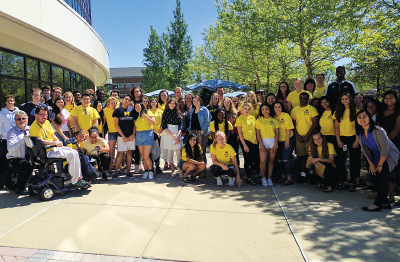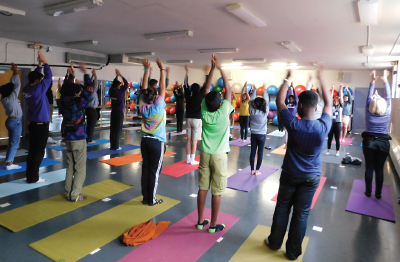Peer Program Helps High Schoolers Handle Depression, Anxiety
Abstract
A peer program in Michigan high schools enables students to raise awareness about mental health issues and where to get help.
Employees at the University of Michigan’s Depression Center noticed they were fielding many requests to give talks about mental health at local public high schools—often following a suicide. Instead of waiting for the next tragedy, the group decided to get proactive, and in 2009 the Depression Center joined forces with the Ann Arbor Public Schools to launch the Peer-to-Peer Depression Awareness Campaign.

Peer-to-Peer student team members, school mentors, and Depression Center staff at the 2017 end-of-school-year celebration.
The campaign was built on the premise that high schoolers are more likely to listen to each other than they are to listen to well-meaning adults, explained Stephanie A. Salazar, M.P.H., outreach and education program manager at the University of Michigan Depression Center.
The program works by educating small teams of students from each high school about depression and related illnesses and then supporting them in finding creative ways to convey this knowledge throughout their school. The aim is to reduce stigma, raise awareness, encourage help-seeking when needed, and ultimately, to help to promote the early detection of mental disorders such as depression, anxiety, and bipolar disorder.
Two years prior to the launch of the Peer-to-Peer Depression Awareness Campaign, the Depression Center began by training Ann Arbor public high school teachers and administrators on risk factors for suicide and depression/anxiety awareness. “Teachers are in a unique position to notice when a student is struggling, reduce stigma, and create a culture of mental health awareness,” Salazar said. Teachers have varying degrees of comfort in dealing with classroom mental health issues, so the training helps to equip teachers with referral resources and make sure they know how to handle various mental health situations, she added.
The center also created a website offering ways teachers could increase positive mental health for their entire classroom and create a culture of awareness and support. “The worst thing you can have is a student raise their hand and say ‘Hey, I need help’ and not have the teacher know how to respond,” Salazar said.
Each year, a small team of five to 20 students from each school forms and attends an all-day group training session led by social workers and psychiatrists. The students are taught evidence-based information about mental health, coping skills, and peer support resources, as well as information about social marketing strategies and active listening skills.
A peer team often includes students who have struggled with anxiety or depression themselves, but who have since overcome their problems, Salazar said. The students aren’t trained to be peer counselors, but rather to be educators around mental health and to encourage students to seek help from counselors when needed.
One of the major strengths of the program is that it pairs the expertise of mental health professionals with the voice of the students to create a uniquely powerful awareness campaign. The students themselves come up with the program design, Salazar said. “They know what the issues are in their school better than anybody.”

Peer-to-Peer student team members practice positive coping strategies at the 2017-2018 educational conference.
Students have put together all-school assemblies, made posters and flyers, created original songs and poetry, shot videos, and done classroom giveaways, such as wristbands and stress balls for the program. “They’re very creative,” she said. A recent Peer-to-Peer team held a schoolwide mental health presentation that included one student sharing her own story about her struggle with depression. “You could tell that everyone was paying attention. There were no side conversations,” Salazar said.
Salazar said she is careful to prevent videotaping of the student team members to protect their privacy. And she does talk with them in advance about the possible consequences of being open with their peers about their struggles with mental health.
A teacher or counselor within each school volunteers to serve as a program mentor. The mentor, along with staff from the University of Michigan’s Depression Center, review the students’ project proposals prior to campaign launch to ensure it includes accurate, safe, and effective messaging. For the first year of a school’s program, mentors rely heavily on school staff to help identify student “champions” from each grade level who would make the best Peer-to-Peer team members. But after a few years, students tend to self-select to participate, and some sites even need an application process because they get such great interest from students in becoming team members, Salazar said.
The entire school takes a survey before and after the Peer-to-Peer campaign, Salazar said. A study of the program posted March 1 in Psychiatric Services in Advance found that 71 percent of students who were not on the peer campaign teams said they were aware of the program’s general publicity campaign and 33 percent attended its additional specialized programs. Participants showed improved knowledge and attitudes toward depression, increased confidence in identifying and referring peers with depression, improved help-seeking intentions, and reduced stigma.
“Tapping into youth voices is a huge part of the success of the Peer-to-Peer program,” wrote study author Sagar V. Parikh, M.D., a professor of psychiatry and associate director of the University of Michigan Depression Center. Positive outcomes were observed among student team members, as well as other students who were exposed to the campaigns’ messages, demonstrating the program’s value as a universal prevention program, the study concluded.
After a campaign, students are less likely to say they’d keep a student’s depression or suicide intent a secret, Salazar said. She has seen a shift, too, in school culture, with students talking about mental health more, and becoming more likely to seek help, too. With nine years of high school success under its belt, the program is now being piloted at nine Ann Arbor middle schools. ■



